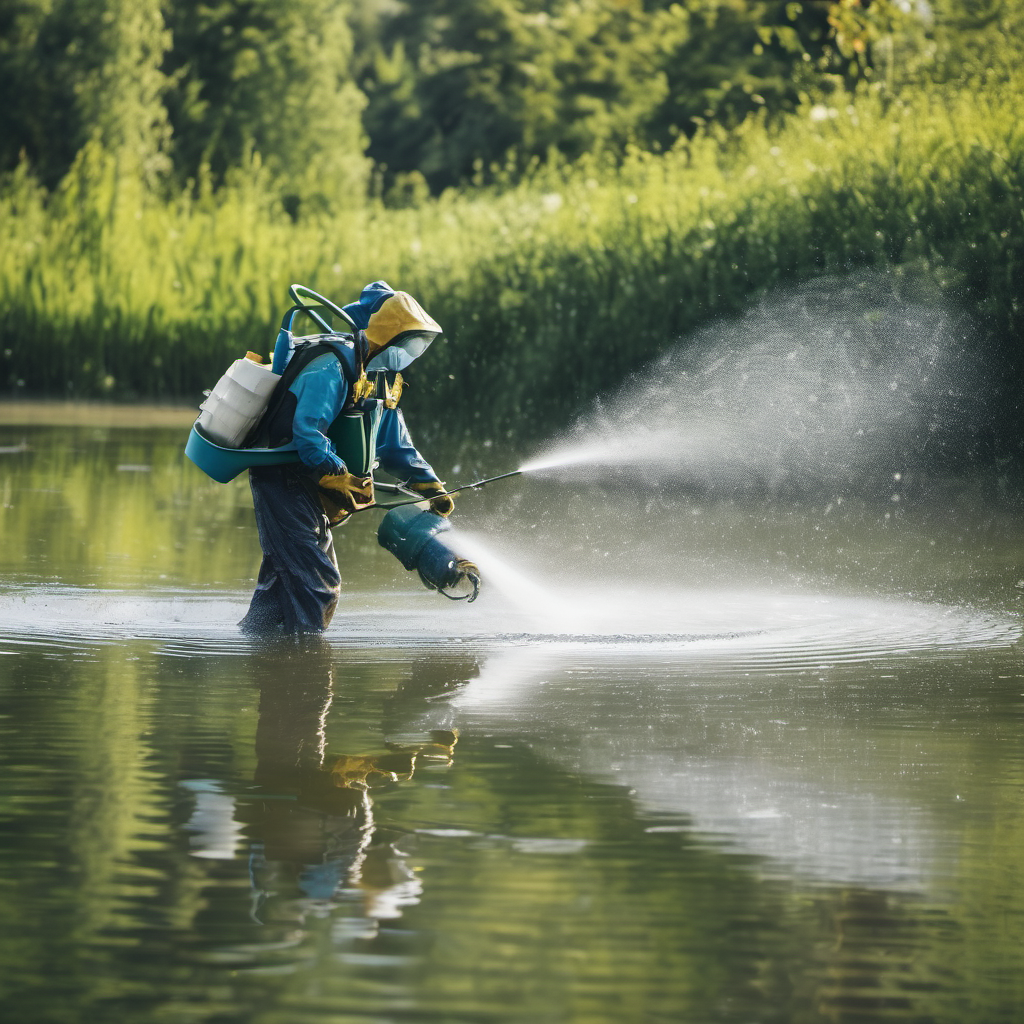GREEN MOUNTAINS, RED FLAGS: UNCOVERING HERBICIDE HARMS AND CULTIVATING CHANGE THROUGH VERMONT LEGISLATION
By Anna Ploof | Staff Editor
April 29, 2024
—
Rachel Carson famously stated, “If we are going to live so intimately with these chemicals—eating and drinking them, taking them into the very marrow of our bones—we had better know something about their nature and their power.”[1]
In early 2022, Vermont residents discovered the overly simplistic process for acquiring a permit to spray herbicides in shared lakes to eradicate aquatic plants. This discovery sparked a heated debate regarding the use of herbicides in Vermont’s lakes.[2] The Vermont legislature needs to balance the harms of herbicides and the potential impacts of non-native aquatic plants when considering whether to approve or deny an herbicide permit.
Aquatic herbicides can have long-lasting effects on humans, aquatic life, and terrestrial organisms.[3] Early herbicide studies frequently overlook possible harmful effects. For example, glyphosate was once believed to be safe but was later classified as carcinogenic to humans by the International Agency for Research on Cancer in 2015.[4] 2,4-D is another ingredient that was initially believed to be safe.[5] According to a senior scientist at the Natural Resources Defense Council, the connection between 2,4-D and cancer in humans “[is not] clear enough” in early studies.[6] Even though there is data connecting 2,4-D to non-Hodgkin’s lymphoma (blood cancer), sarcoma (soft-tissue cancer), and thyroid disorders, this herbicide was still registered in the United States.[7] Moreover, compelling evidence suggests that 2,4-D has endocrine-disrupting properties by either mimicking or inhibiting the body’s hormones.[8] Following the registration of an herbicide, concerning signs gradually emerge.[9] Yet many findings remain inconclusive despite recent research.[10]
In addition to an herbicide’s potential impact on humans, it can impact aquatic life. Even if an herbicide fails to kill an aquatic organism, there may still be sublethal effects.[11] Sublethal effects manifest when an organism experiences alterations in behavior such as weight loss, reduced agility and defense mechanisms, and lower tolerance to high temperatures.[12] Moreover, herbicides have the potential to induce mutations and abnormalities in fish larvae.[13]
The potential impacts of non-native aquatic plants are that they can compete with native plant species,[14] non-native plants can change the fish populations based on decreased predation,[15] and that the abundance of non-native plants can be an inconvenience for lake-goers.[16] In comparison, the possible harm from herbicides is much greater than that of non-native aquatic plants.
The Environmental Protection Agency (EPA) mandates herbicide registration under the Federal Insecticide, Fungicide, and Rodenticide Act (“FIFRA”).[17] In the Supreme Court decision, Wisconsin Public Intervenor v. Mortier, the Court held that FIFRA does not preempt local regulations,[18] allowing state and local governments to fill in the gaps.[19] Thus, Vermont should enact stricter legislation regarding herbicide permitting for non-native aquatic plants. Vermont can better the legislation in four ways. First, by creating an interagency task force to create a comprehensive non-native plant species management plan and to review herbicide permits around the state. Second, enhancing recognition of the common-law public trust doctrine to reinstate sufficient safeguards for the public’s right to utilize the state’s natural resources. Third, adhering to the Administrative Procedure Act by giving weight to public input and facilitating a better process for public comment. Lastly, mandating public education on herbicides and non-native plants. If none of these methods are considered, at the very least, Vermont should employ the precautionary principle in herbicide legislation.
—
[1] Rachel Carson, Silent Spring 17 (25th ed.1962).
[2] Emma Cotton, Denial of Herbicide Permit for Lake Bomoseen Would End Long Controversy, vtdigger (July 5, 2023), https://vtdigger.org/2023/07/05/state-set-to-deny-permit-for-herbicides-on-lake-bomoseen.
[3] IARC Monograph on Glyphosate, World Health Org. (July 19, 2018), https://www.iarc.who.int/featured-news/media-centre-iarc-news-glyphosate/; Danielle Sedbrook, 2,4-D: The Most Dangerous Pesticide You’ve Never Heard of, Nat. Res. Def. Council (Mar. 15, 2016), https://www.nrdc.org/stories/24-d-most-dangerous-pesticide-youve-never-heard (both sources indicating the different health implications of herbicides on humans); Louis A. Helfrich, Pesticides and Aquatic Animals: A Guide to reducing Impacts on Aquatic Systems 6 (2009), https://vtechworks.lib.vt.edu/bitstream/handle/10919/48060/420-013_pdf.pdf (explaining sublethal effects of herbicides on fish); see Oluwaseun Olusegun Babalola & Hannes Johannes van Wyk, Impacts of Diquat Dibromide Herbicide Formulation on Amphibian Larval Development, Nat’l Ctr. of Biotechnology Info. (Apr. 13, 2021), https://www.ncbi.nlm.nih.gov/pmc/articles/PMC8066383/ (stating that a type of herbicide disrupts amphibian growth); Diquat Ecological Risk Assessment Final Report, Bureau of Land Mgmt. (Nov. 2005), https://digitalcommons.usu.edu/cgi/viewcontent.cgi?article=1102&context=govdocs (stating that a type of herbicide is “moderately toxic to birds and honeybees.”).
[4] IARC Monograph on Glyphosate, supra note 2.
[5] Id.
[6] Sedbrook supra, note 3.
[7] Id.;see About Pesticide Registration, Env’t Prot. Agency (Jan. 4, 2024), https://www.epa.gov/pesticide-registration/about-pesticide-registration (stating registration is based off of current scientific data and that herbicides must be registered before they are used in the United States).
[8] Sedbrook, supra, note 3
[9] Id.
[10] Id.
[11] Alan G. Heath, Sublethal Effects of Pesticides on Fishes, Va. Polytechnic Inst. and State Univ., https://ucanr.edu/repository/fileaccess.cfm?article=161542&p=JNBAWA (last visited March 11, 2024).
[12] Louis A. Helfrich, Pesticides and Aquatic Animals: A Guide to reducing Impacts on Aquatic Systems 6 (2009), https://vtechworks.lib.vt.edu/bitstream/handle/10919/48060/420-013_pdf.pdf.
[13] Beyond Pesticides, Fish and Other Aquatics, https://www.beyondpesticides.org/programs/wildlife/fish (last visited March 11, 2024).
[14] Common Mid-Atlantic Invasive Aquatic Plants, Aquatic Env’t Consultants, https://aeclakes.com/resources/common-mid-atlantic-invasive-aquatic-plants/ (last visited March 11, 2024).
[15] William E. Lynch, Benefits and Disadvantages of Aquatic Plants in Ponds 2–3 (2006), https://woodlandstewards.osu.edu/sites/woodlands/files/imce/0017%20%281%29.pdf.
[16] Aquatic Nuisance Species, Env’t Prot. Agency (Mar. 9, 2023), https://www.epa.gov/vessels-marinas-and-ports/aquatic-nuisance-species-ans.
[17] Federal Insecticide, Fungicide, and Rodenticide Act (FIFRA) and Federal Facilities, Env’t Prot. Agency (Feb. 15, 2023), https://www.epa.gov/enforcement/federal-insecticide-fungicide-and-rodenticide-act-fifra-and-federal-facilities.
[18] 7 U.S.C.A. § 136d(b)(West).
[18] Wis. Pub. Intervenor v. Mortier, 501 U.S. 597, 608 (1991).
[19] Id. at 613.

